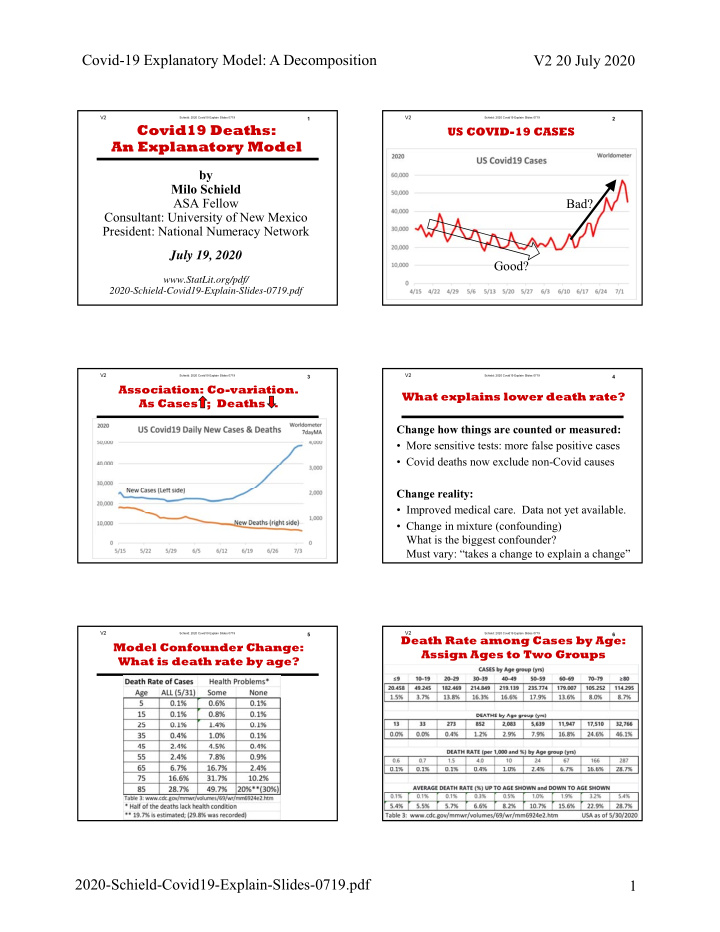



Covid-19 Explanatory Model: A Decomposition V2 20 July 2020 V2 V2 Schield: 2020 Covid19 Explain Slides 0719 1 Schield: 2020 Covid19 Explain Slides 0719 2 Covid19 Deaths: US COVID-19 CASES An Explanatory Model . by Milo Schield ASA Fellow Bad? Consultant: University of New Mexico President: National Numeracy Network July 19, 2020 Good? www.StatLit.org/pdf/ 2020-Schield-Covid19-Explain-Slides-0719.pdf V2 V2 Schield: 2020 Covid19 Explain Slides 0719 3 Schield: 2020 Covid19 Explain Slides 0719 4 Association: Co-variation. What explains lower death rate? As Cases ; Deaths . . Change how things are counted or measured: • More sensitive tests: more false positive cases • Covid deaths now exclude non-Covid causes Change reality: • Improved medical care. Data not yet available. • Change in mixture (confounding) What is the biggest confounder? Must vary: “takes a change to explain a change” V2 V2 Schield: 2020 Covid19 Explain Slides 0719 5 Schield: 2020 Covid19 Explain Slides 0719 6 Death Rate among Cases by Age: Model Confounder Change: Assign Ages to Two Groups What is death rate by age? . . 2020-Schield-Covid19-Explain-Slides-0719.pdf 1
Covid-19 Explanatory Model: A Decomposition V2 20 July 2020 V2 V2 Schield: 2020 Covid19 Explain Slides 0719 7 Schield: 2020 Covid19 Explain Slides 0719 8 The Cases-Deaths Association: Two-Group Risk Model Confounded by Age-Risk Mix . We need a simple explanatory model . Assume two groups based on risk of death: • Death rate: High risk (R1), Low risk (R2) Let F1 = Fraction of cases in high risk group Deaths = Cases*[F1*R1 + (1-F1)*R2] Select death rates for each group: R1 > R2 • Max(Deaths/Cases) = 8.2%. So let R1 = 10% • Min(Deaths/Cases) = 1.0%. So let R2 = 0.1% V2 V2 Schield: 2020 Covid19 Explain Slides 0719 9 Schield: 2020 Covid19 Explain Slides 0719 10 92% of Deaths from 11% of Cases. 67% of Deaths from 4% of Cases. High Risk: Old with Health Problems High Risk: Old with Health Problems . . V2 V2 Schield: 2020 Covid19 Explain Slides 0719 11 Schield: 2020 Covid19 Explain Slides 0719 12 Statistical Education Technical Summary needs Statistical Literacy 1. Smooth the data (7day average) Look at what was done here: 2. Model the data: Predict vs. Explain • Observational data; time series data, big data 3. Look for biggest confounder: Age-risk mix • Model to explain (not trying to predict) 4. Confounder must vary as data changes. • Confounder that varies over time 3. Choose a simple model to highlight essentials • Create a simple 2-parameter model 4. Check model assumptions against real data. None of these are taught in traditional intro stats. 5. Summarize results to highlight the findings These are more of the reasons why students need a 6. Help officials minimize deaths and flatten the confounder-based Statistical Literacy course. curve without flattening the economy 2020-Schield-Covid19-Explain-Slides-0719.pdf 2
V2 Schield: 2020 Covid19 Explain Slides 0719 1 Covid19 Deaths: An Explanatory Model by Milo Schield ASA Fellow Consultant: University of New Mexico President: National Numeracy Network July 19, 2020 www.StatLit.org/pdf/ 2020-Schield-Covid19-Explain-Slides-0719.pdf
V2 Schield: 2020 Covid19 Explain Slides 0719 2 US COVID-19 CASES . Bad? Good?
V2 Schield: 2020 Covid19 Explain Slides 0719 3 Association: Co-variation. As Cases ; Deaths . .
V2 Schield: 2020 Covid19 Explain Slides 0719 4 What explains lower death rate? Change how things are counted or measured: • More sensitive tests: more false positive cases • Covid deaths now exclude non-Covid causes Change reality: • Improved medical care. Data not yet available. • Change in mixture (confounding) What is the biggest confounder? Must vary: “takes a change to explain a change”
V2 Schield: 2020 Covid19 Explain Slides 0719 5 Model Confounder Change: What is death rate by age? .
V2 Schield: 2020 Covid19 Explain Slides 0719 6 Death Rate among Cases by Age: Assign Ages to Two Groups .
V2 Schield: 2020 Covid19 Explain Slides 0719 7 The Cases-Deaths Association: Confounded by Age-Risk Mix We need a simple explanatory model . Assume two groups based on risk of death: • Death rate: High risk (R1), Low risk (R2) Let F1 = Fraction of cases in high risk group Deaths = Cases*[F1*R1 + (1-F1)*R2] Select death rates for each group: R1 > R2 • Max(Deaths/Cases) = 8.2%. So let R1 = 10% • Min(Deaths/Cases) = 1.0%. So let R2 = 0.1%
V2 Schield: 2020 Covid19 Explain Slides 0719 8 Two-Group Risk Model .
V2 Schield: 2020 Covid19 Explain Slides 0719 9 92% of Deaths from 11% of Cases. High Risk: Old with Health Problems .
V2 Schield: 2020 Covid19 Explain Slides 0719 10 67% of Deaths from 4% of Cases. High Risk: Old with Health Problems .
V2 Schield: 2020 Covid19 Explain Slides 0719 11 Technical Summary 1. Smooth the data (7day average) 2. Model the data: Predict vs. Explain 3. Look for biggest confounder: Age-risk mix 4. Confounder must vary as data changes. 3. Choose a simple model to highlight essentials 4. Check model assumptions against real data. 5. Summarize results to highlight the findings 6. Help officials minimize deaths and flatten the curve without flattening the economy
V2 Schield: 2020 Covid19 Explain Slides 0719 12 Statistical Education needs Statistical Literacy Look at what was done here: • Observational data; time series data, big data • Model to explain (not trying to predict) • Confounder that varies over time • Create a simple 2-parameter model None of these are taught in traditional intro stats. These are more of the reasons why students need a confounder-based Statistical Literacy course.
Recommend
More recommend